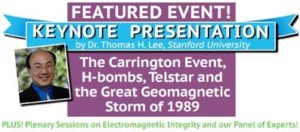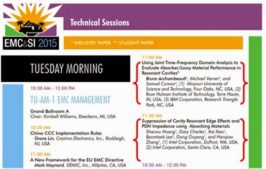The Central Texas Presentation
The potential audience stayed away in droves with the result that the number attending the presentation was disappointing. This seems strange when you consider the Central Texas Chapter capture area has two major EMC chamber manufacturers, and that previous presentations I have given attracted a big audience. A lot of pizza was taken home – but thanks all the same to Nexio EMC Software for sponsoring this. The chapters are given a pittance to cover expenses such as providing hospitality at presentations.
Still, it is an ill wind that blows no good, and the small audience allowed deep discussions during the presentation as opposed to the normally practical requirement of holding all questions to the end.
And those few that did attend were rewarded by witnessing never before seen animations of a wave striking an angled hot-wall.
Some of what the absentees missed
After I reminded the audience about the various optical phenomena to watch out for, and gave my view on why absorber is shaped the way it is (maximizes the number of pyramids you can cut from a block of absorber material), I introduced my alternative ‘non-polarized’ layered-cone absorber design.
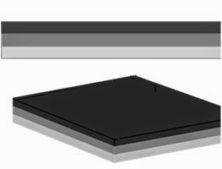 |
| Foam based layered tapered loss approach |
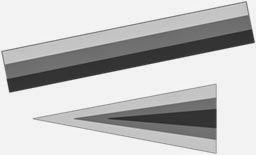 |
|
Layered approach a candidate for absorber cone design
|
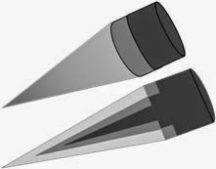 |
|
Non-polarized layered-loss cone design
|
An astute observer spotted the flaw in the design before I got there, and for now it looks like the non-polarized idea won’t fly.
Any blog readers out there spot the flaw?
I have decided to create an ‘Inner Circle’ as regards early access to simulation results. The circle needs to contain a mix of ‘the right stuff’, from hands-on EMC engineers to engineers from outside the industry. The astute observer mentioned above won his spurs in the discussions and is now a member of the Circle.
The Inner Circle will plow it’s own furrow, and so has no use or time for ‘experts’ that know test standards chapter and verse, and blindly defend existing test set-ups. These guys are as much use to the Inner Circle as a chocolate coffee pot.
The expectation is that members will develop from passive observers to live participants in designing experiments that isolate various phenomena.
As I said, it is an ill wind that blows no good, and Ross Carlton of NI may be interested in my offer of on-site test-staff education on the physics behind EMC chamber tests.
If anyone is as keen as I am on using powerful 3D EM software to examine new ways to solve old issues, maybe we can meet up briefly at the Santa Clara show and I can run through the important slides in the presentation over coffee? Or if you wish to be considered for the Inner-Circle think tank, again, maybe we can meet up at the show? ‘Experts’ need not apply.
Talking of Santa Clara, the show is almost upon us.
The Upcoming EMCSI Show in Santa Clara
I have an admission to make – I was under the impression that the Santa Clara show was created purely as a compensatory gesture to those who cannot make the annual August EMC event taking place in Germany this year. I have touched on the Dresden show in previous posts and, in my usual self-righteous manner, concluded that on occasion, it was good to push the international nature of the IEEE. But it still seems a little like two allied political parties ‘splitting the vote’ to neither party’s benefit.
However, now that I am checking the Santa Clara EMSCI website in preparation for attending, my eyes are opening to the fact that this is likely to be an event on par with Dresden. One key indicator is a booth space count of the two exhibition halls. A quick look shows around 196 booth spaces at Santa Clara (plus 16 table top spaces), against the currently planned space for 140 booths at Dresden (plus 50 table tops). In both totals, I took into account the number of booth spaces taken up by the ‘islands’ the bigger companies utilize.
So to all you Cinderellas out there unable to attend Dresden – “you shall go to the ball”, and on the face of it, it is likely every bit as good as the overseas event. Time alone will tell.
So, what should I go see at the show?
The keynote presentation is a must. Made all the more topical with the North Korean threats to South Korea, I have followed the HEMP topic with interest and would be interested to know how the HEMP filters placed at vital establishments guarantee to ‘catch’ the pulse coming in from the grid. Given the short rise-time of the HEMP induced wave, and given the finite time-constant that dictates the performance of all MOV based circuits, the race between the fast-rising pulse and the trigger time of the MOV is likely a race too close to call. Could be the MOV triggers 10 times faster than the time it takes the pulse to rise to a damage level. Somehow I doubt this. Or maybe giant ferrites slow the leading edge of the pulse giving the MOV time to trigger. The great thing about a show is that there is always someone there that knows.
So that is 8:30 – 10:00AM on Tuesday gone, and given my interest in absorber technology as regards chamber performance, I will definitely shoot at attending two papers on the use of absorbers at 11:00 and at 11:30AM. I already marked them in red on the program.
Then between 1:30 and 3:00PM there are panel discussions where the second panellist, and I quote, ‘…. will present aspects of absorber material and their principles of operation including various test methodologies for quantifying absorber effectiveness.’ Right up my street – yes please.
Naturally I shall be meeting with Dr Andreas Barchanski of CST at booth #412 to discuss the work on diagnosing the underperformance of 3m chambers. Add to this a bunch of scheduled meetings, and add a hunt on the exhibit floor for the newest and greatest new products out there, and I doubt there will be much time for lazing around.
To be continued …….
Tom Mullineaux
Lionheart Southwest

